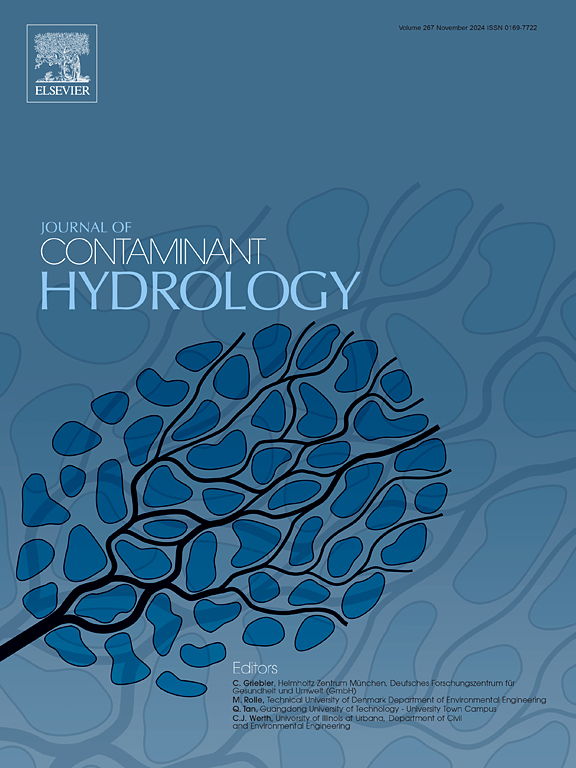Effect of flow velocity and particle concentration on cotransport of zinc oxide and copper oxide nanoparticles in soil
IF 4.4
3区 环境科学与生态学
Q2 ENVIRONMENTAL SCIENCES
引用次数: 0
Abstract
Zinc oxide (nZnO) and copper oxide (nCuO) nanoparticles are widely used in many industrial applications. This results in their inevitable release into the soil and groundwater. This study investigated the cotransport behavior of nZnO and nCuO in saturated soil through column experiments and mathematical modeling. We observed decreased nZnO and nCuO transport during their cotransport compared to their individual transport. This is due to the formation of large-sized nZnO-nCuO heteroaggregates, which have a greater retention in soil than free nZnO and free nCuO. Further, the reduction in the transport was greater for nCuO than nZnO due to the greater affinity of nCuO to attach to the grain surfaces and the larger mass fraction of nCuO in the heteroaggregates. The retarded transport of nZnO and nCuO decreased with increasing flow velocity and increasing nZnO: nCuO injection concentration ratio in the order 2:1, 1:2, and 1:1. The experimental results were successfully simulated using a mathematical model that fully coupled the transport of nZnO and nCuO by incorporating the kinetics of heteroaggregation of nZnO and nCuO and heteroaggregate retention in soil.
流速和颗粒浓度对氧化锌和氧化铜纳米颗粒在土壤中协同迁移的影响
氧化锌(nZnO)和氧化铜(nCuO)纳米颗粒广泛应用于许多工业应用。这导致它们不可避免地释放到土壤和地下水中。通过柱试验和数学模型研究了饱和土壤中nZnO和nCuO的共输运行为。我们观察到,在它们的共同运输过程中,与单独运输相比,nZnO和nCuO的运输减少了。这是由于形成了大尺寸的nZnO-nCuO异质团聚体,其在土壤中的滞留量大于游离的nZnO和游离的nCuO。此外,由于nCuO对晶粒表面的亲和力更强,并且nCuO在异聚集体中的质量分数更大,因此nCuO对转运的减少比nZnO更大。随着流速的增大和nZnO: nCuO注射浓度比的增大,nZnO和nCuO的阻滞输运率依次为2:1、1:2和1:1。通过将nZnO和nCuO的异聚集动力学和异聚集滞留动力学结合起来,建立了nZnO和nCuO运移完全耦合的数学模型,成功地模拟了实验结果。
本文章由计算机程序翻译,如有差异,请以英文原文为准。
求助全文
约1分钟内获得全文
求助全文
来源期刊

Journal of contaminant hydrology
环境科学-地球科学综合
CiteScore
6.80
自引率
2.80%
发文量
129
审稿时长
68 days
期刊介绍:
The Journal of Contaminant Hydrology is an international journal publishing scientific articles pertaining to the contamination of subsurface water resources. Emphasis is placed on investigations of the physical, chemical, and biological processes influencing the behavior and fate of organic and inorganic contaminants in the unsaturated (vadose) and saturated (groundwater) zones, as well as at groundwater-surface water interfaces. The ecological impacts of contaminants transported both from and to aquifers are of interest. Articles on contamination of surface water only, without a link to groundwater, are out of the scope. Broad latitude is allowed in identifying contaminants of interest, and include legacy and emerging pollutants, nutrients, nanoparticles, pathogenic microorganisms (e.g., bacteria, viruses, protozoa), microplastics, and various constituents associated with energy production (e.g., methane, carbon dioxide, hydrogen sulfide).
The journal''s scope embraces a wide range of topics including: experimental investigations of contaminant sorption, diffusion, transformation, volatilization and transport in the surface and subsurface; characterization of soil and aquifer properties only as they influence contaminant behavior; development and testing of mathematical models of contaminant behaviour; innovative techniques for restoration of contaminated sites; development of new tools or techniques for monitoring the extent of soil and groundwater contamination; transformation of contaminants in the hyporheic zone; effects of contaminants traversing the hyporheic zone on surface water and groundwater ecosystems; subsurface carbon sequestration and/or turnover; and migration of fluids associated with energy production into groundwater.
 求助内容:
求助内容: 应助结果提醒方式:
应助结果提醒方式:


